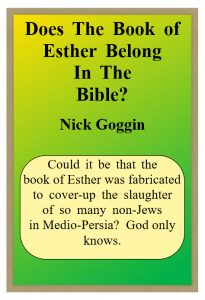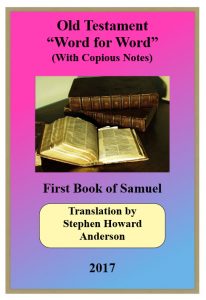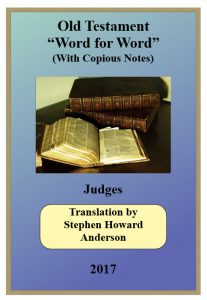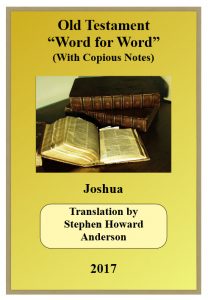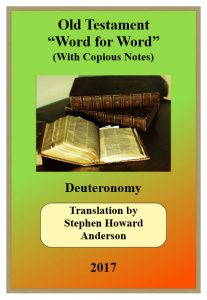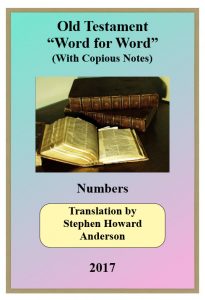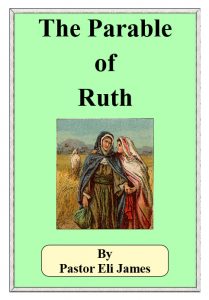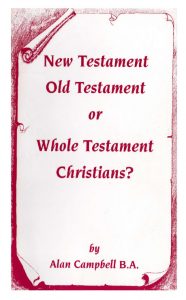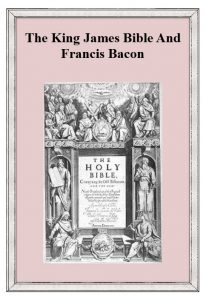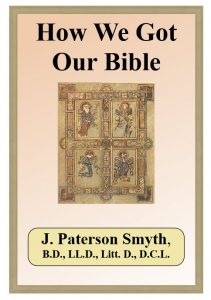As many know, the name of “God” or “Lord” does not appear even once in the book of Esther. And I reject the Companion Bible’s assertion that it is hidden in acrostics seems a little too convenient (made up after the fact?) and Kabalistic to me. Especially as there is no rhyme nor reason as to how the so-called acrostics are located. It is as though someone just looked through the book for a couple of instances where certain words followed one another. Remember that Bullinger was a friend of the converted Jew Ginsburg, and that Ginsburg was studied in the Cabbala (Kabbalah). This type of counting and letter sequencing seems very Kabalistic. I just don’t like the feel of it, at all; it seems eerily reminiscent of the “Bible Code” type spurious books. “…no lie is of the truth” (1 John 2:21).
Download Tag: Scripture
Word for Word 8 1 Samuel
Sepher Shemu’el 1
(First Book of Samuel)
THE BOOK OF SHEMU’EL (8050 Samuel) was one book until 1517, when the “Hebrew Bible” was published. This change into two separate books was influenced by the “church” of Rome, and is another wrongful modification of Scripture. I was going to recombine them, but decided that it would cause unnecessary confusion for those trying to reference this text from other versions of the Bible that are now in print.
Shemu’el held the “office” of Prophet. He was the last of the Shophetiym (Judges) in Yisrael. He bridges the gap between “judges” and “kings” in Yisrael. This book shows Yisrael foolishly desiring a “king”, to be like the other nations around them who did not worship Yahweh. Bad decision on their part. Shemu’el means “asked of El”, from sha’al 7592, to ask as a favor, or to lend or borrow, plus 410, El, as a title “God”, referring to Yahweh. See verses 1:20, 27, and 28 for reference to the reason for this name for the boy Shemu’el.
Word for Word 7 Judges
Sepher Shophetiym
(The Book of Judges)
JUDGES HERE DOES NOT MEAN A “JUDGE” as in a courtroom today. In Hebrew, it carries more of the meaning of a “leader” than anything else. This could be a civil leader, or a religious leader, or a prophet that had a lot of influence in the nation. One man as a “judge” did not rule over all of Yisrael. Indeed, sometimes several were at work at one time during the period, which lasted about 350 years. Shemuel (8050 Samuel) was the probable author of this book, and most likely while he was living. Only thirteen of the fifteen judges are in this book. Eliy (5941 Eli) and Shemuel are in 1 Samuel. Here, chapters 1 and 2 are an introduction, and 3 through 16 recount the stories of the judges who led or rescued the people. Chapters 17 through 21 describe the conditions of the times. Neither the introduction, nor the conclusion follow the time-line of the story order of the judges.
The order of the judges are, Othniyel (6274), Ehud (261), Shamgar (8044), Deborah (1683), Gideon (1439), Abiymelech (40, Abimelech), Tola (8439), Yaiyr (2971, Jair), Tiptach (3316, Jephthah), Ibtsan (78,Ibzan), Eylon (356, Elon), Abdon (5658), and Shim’shon (8123, Samson). Mikayehu (4321, Micah) was not a judge, but had a false priest, and worshiped idols, and is in chapter 17 following the story of Shim’shon. Please remember, some of the judges were not all “good”, and made some personal mistakes, but served the purpose called for by Yahweh. Shim’shon was a good example of this at his end.
Word for Word 6 Joshua
Sepher Yahshua
[ Book of Joshua ]
The Book of Yahshua is a continuation of the journey of the people of Yisrael into the “Promised Land” across the Yarden River. They would be required to fight several bloody battles for this territory, and were commanded by Yahweh to completely destroy the “cursed seed” people, so they would not be a “thorn in the side” in the future. Yisrael did not accomplish this, and these people are a “thorn” today. Yahshua’s very name means Yah is salvation, and is the identical Hebrew name of the Messiah, Yahshua. It has been tampered with in spelling over the years, and I have restored it to the original form, without regard to the erroneous Masoretic vowel point version.
The Talmudists have done all they could to hide the Name of Yahweh, and as Yah(weh) is part of the name of Yah(shua), they have altered it as well. As in my other works, a word or number(Strong’s) in italics is inserted for ease of reading, or for information purposes, but is NOT IN the Hebrew text. Names of places and people in the margin are spelled as in the KJV for reference purposes. In the text itself they will be in transliterated form of the Hebrew.
Word for Word 5 Deuteronomy
Sepher Elleh Debariym
(Book of Deuteronomy)
I HAVE BEGUN THIS COMPUTERISED VERSION IN NOVEMBER 2016. There were some text errors in the earlier versions, due to lack of sufficient research material when I first typed it. I have stated that this will be an ongoing work, and whenever new knowledge is available, and would make changes necessary, they would be made. Nothing is more important than accuracy when dealing with Scripture.
“Deuteronomy” is translated as “Second Law” in the Septuagint, but the actual name of the book is “These Are The Words” – Elleh 428 Debariym 1697 plural. The book begins with these words, and thus the Hebrew title for the book. This is not a “second law”, but a repetition of what Mosheh had said to Yisrael previously. An entirely new generation had arisen in Yisrael, and the old one had perished in the wilderness. The new folks needed to hear these words, and Mosheh wrote them down, and the scroll was placed in the Ark of the Covenant.
As in the other four books of Mosheh, proper names will be in the transliteration format, as they are spelled in Hebrew. If you want the KJV spelling, refer to your KJV. I will not indicate Masoretic vowel points, as they are often in error, and varied from scribe to scribe as to spelling. They were for help in pronunciation, but the scribes changed much of the text to hide the Holy Name of Yahweh. They substituted #136 adonay for The Name, because of Jewish “tradition”. I have indicated where this has occurred in the margin notes, and have replaced the Name of Yahweh where it belongs.
Chapter notes are mine, and you may agree or disagree as you please. I am Yisrael Identity in belief, and Scripture firmly supports this. If you think you have found error, look it up for yourself. My research material is as follows –
Complete Word Study Old Testament, and the Dictionary for it (AMG Publishers) Brown, Driver, Briggs, Gesenius Hebrew/English Lexicon (Hendrickson Publishers)
Strong’s Exhaustive Concordance (Nelson Publishers)
A Tanak for the Hebrew (J.P.S.). The JPS Tanak is the most accurate I could find as to the Hebrew, but anything published by Jews needs careful examination. Their “English translation” is an absolute fraud. It does not even approach saying what the Hebrew says, so don’t even bother with it.
Words that are underlined are one word in the Hebrew, even though several words are used in English. Strong’s numbers will follow words where needed in italics, but I will only do this a few times, and then only the word will be used.
This work is Copyrighted © by Stephen Howard Anderson, and may not be commercially reproduced without written permission from the translator. If quoted in a publication, credit must be given to the translator for the quoted material, and no alterations may be made to the material being quoted.
Stephen Howard Anderson, Translator
Word for Word 4 Numbers
rabdmb B’mid’bar
( Book of Numbers )
THE ACTUAL NAME OF THIS BOOK IS “IN THE WILDERNESS”. It has been changed to “Numbers”, because they mustered the troops, and counted them, so they called it “Numbers”. In this book, there are often several men with the same name in some passages, and they must be differentiated by their FATHER’s name. As in my prior works, all proper names of people and places will be in the Hebrew spelling, with English letters. When several English words are need for one Hebrew word I will underline them for the first usage, followed by their Strong’© number. Compare this text with whatever translation you use, and you will note the differences where the scribes have tampered with the verses. Don’t be surprised at some radical differences, as the scribes have done much damage. Where Yahweh is speaking, the text will be in bold type.
This work is Copyrighted © by Stephen H. Anderson, and may not be reproduced for profit. Quotations from the text are permitted, but only with no alterations, and due credit given to the translator. Enjoy your studies, and may Yahweh Bless and Keep You.
Stephen H. Anderson, Translator
The Parable of Ruth
The Story of Ruth has been treated only as a historical account of one of the ancestors in the line of Yahshua. Ruth’s second husband, Boaz, was a Patriarch of that lineage. Ruth and Boaz bore Obed, the father of Jesse, and grandfather of David. Much speculation has been purveyed about Ruth’s racial ancestry. Those who preach the gospel of race-mixing insist that Ruth was a non-Israelite. A careful reading of the text proves otherwise, as Ruth is called the near kinswoman of Boaz. (Ruth 3:12.) Boaz’s exact words to her are, “And now it is true that I am thy near kinsman: howbeit there is a kinsman nearer than I.”
New Testament, Old Testament or Whole Testament
I wonder if any of my readers have ever attempted to collect a set of books or magazines, only to find that one part was missing. It was so frustrating, without that missing part the story was unintelligible, you simply could not get the grasp of it because the vital, often the fundamental part was missing.
YET, today millions of professing Christians and tens of thousands of clergy, dismiss’ the Old Testament out of hand. They declare it to be of little or no importance and instead of having a Whole Testament, all sixty six books, they arrogantly and ignorantly boast of being “New Testament Christians”.
In order to set the record straight, once and for all, there are some vital questions we need to consider.
Francis Bacon and The King James Bible
In his first regnal year, King James presided over a conference between Episcopalians and Puritans. The primary topic for discussion concerned the numerous, and sometimes conflicting versions of the Bible—most of which were not written in English.
The Puritan leader John Rainoldes stressed the need for a uniform English translation of the Bible. The King approved the idea, and commissioned a force of 54 translators to execute the project. The translators were then arranged into six groups operating under specific guidelines. It was the consummate set-up. Bacon had every intention of producing his own translation of the Bible since his teen years, and the King provided the perfect opportunity and means for its implementation—along with the ideal cover for which Bacon was only too happy to insure that James would receive full credit for the undertaking. Hence, the “Bacon Bible” would forever be known as the King James Version by virtue of Bacon‘s need for a patron to finance such an immense project, and a front man behind which he could operate with complete invisibility.
How We Got Our Bible
LET the scope of this book be clearly understood. The question How we got our Bible is a very wide one and the full answer should tell of the making of the Bible and the writers of the Books and the ancient historical material which they used and also how it happened that this particular collection of books came to be separated from the other literature of the time and regarded as inspired and collected into a Bible. This part of the answer I have already tried to give in another book.
The present treatise takes the answer at a later stage when the books were already completed and received as the inspired guide of the Church. It traces the story of the Bible from the early manuscripts of Apostolic days down to the last Revised Version which is in our hands to-day.’
